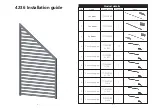
4-8
IM CA71-E
4.3 Sourcing Resistance or RTD Signal
• The calibrator sources a resistance signal by 1) receiving
the resistance-measuring current I supplied from the device being
calibrated, such as a resistance meter or RTD thermometer, and 2)
delivering the voltage V = R × I proportional to the preset resistance
R between the output terminals, and 3) thus producing the equivalent
resistance R = V/I. Consequently, the calibrator sources the signal
correctly only for such devices that employ this method of
measurement.
• The allowable range of the resistance measuring current I that
the calibrator receives from a resistance measuring device under
calibration is rated as 0.1 to 5 mA. Note, however, that accuracy
lowers for resistance measuring currents smaller than 0.5 mA.
For further details, see Chapter 12, “Specifications.”
• Any resistance signal being sourced does not include the resistance
component of the lead cables for source.
The calibrator is adjusted so that the signal has a resistance value as
viewed from the output terminals.
The whole resistance, when measured at the ends of the lead cables
for source, is given by adding the resistance of the lead cables
themselves (approximately 0.1 Ω on a round-trip basis) to the sourced
resistance signal.
For source of precise resistance signals, use three-wire connection.
• If capacitance between the terminals of a device under calibration is
greater than 0.1 µF, the calibrator may fail to source correct resistance
signals.
4.3 Sourcing Resistance or RTD Signal
















































